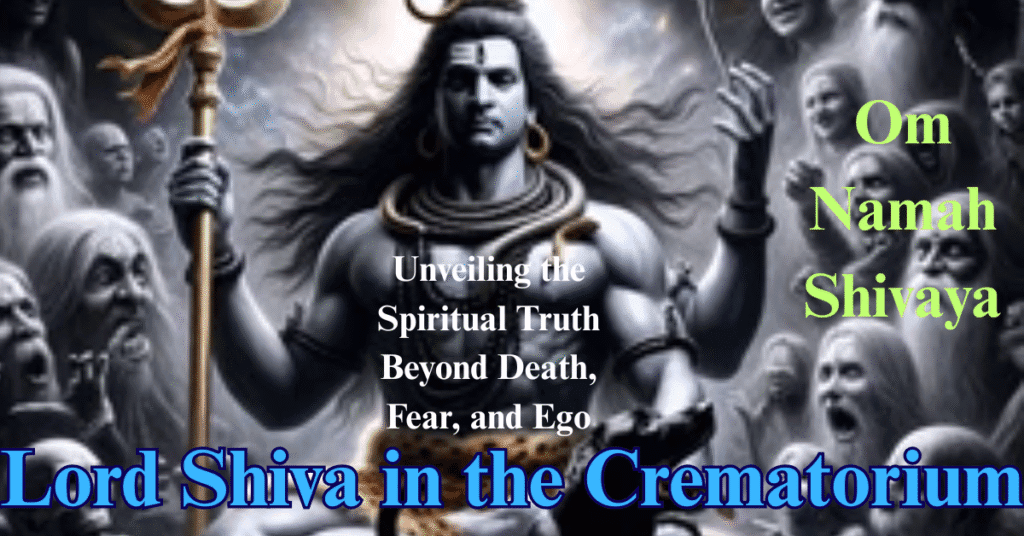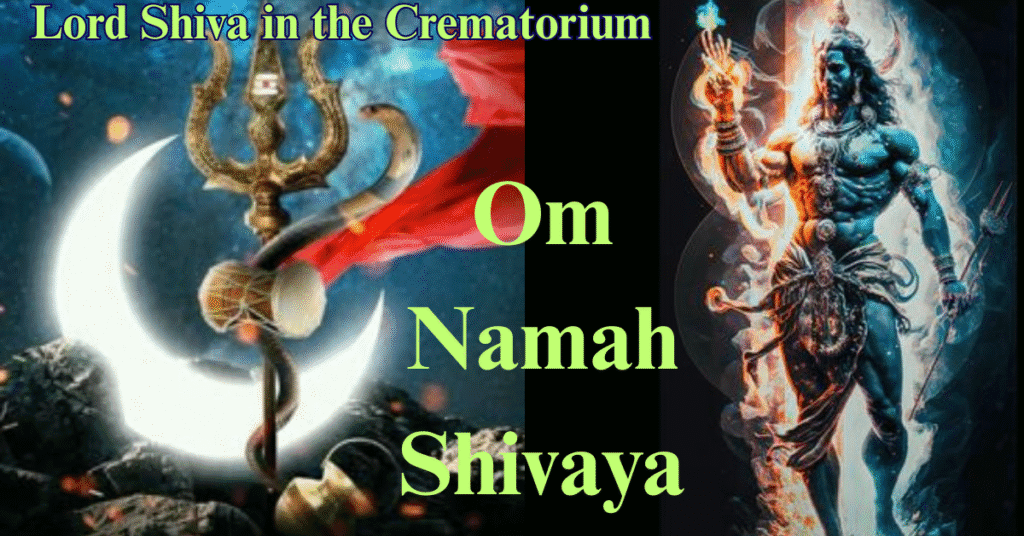
Table of Contents
Lord Shiva in the Crematorium
Lord Shiva in the Crematorium : In most religious traditions, gods are imagined in radiant temples, surrounded by incense, gold, and music. But in Hinduism, Lord Shiva breaks every stereotype. He doesn’t sit on a jewel-studded throne or demand elaborate offerings. Instead, Shiva chooses to reside in the crematorium — a place that most of us fear, avoid, or refuse to acknowledge.
Known as Shmashanavasi, “the dweller of the cremation ground,” Shiva finds divine presence where others only see sorrow and death. Why? Because Shiva is the embodiment of absolute truth, untouched by illusion or social conditioning. To understand why Shiva is worshipped in such a place, we must journey beyond the surface — into philosophy, symbolism, and deep spiritual insight.
The Unconventional Abode of Lord Shiva
Why Shiva Is Worshipped in the Crematorium: A Journey Beyond Fear, Ego, and Illusion

1. Lord Shiva Represents Dissolution – The Cosmic Return
In the sacred Hindu Trinity or Trimurti, three cosmic functions are divided among Brahma (creation), Vishnu (preservation), and Shiva (destruction or dissolution).
But Shiva’s destruction is not negative. It is a compassionate dissolution of ego, illusion, and bondage. It is the return of the soul to its source. The crematorium symbolizes this dissolution.
When a body is burned on the pyre, it’s not just physical death — it’s a spiritual reminder. Everything we cling to — status, wealth, beauty — will turn to ash. In such a place, Shiva sits peacefully, reminding us that the only eternal reality is the soul (Atman).
Worshipping Shiva in the crematorium is not worshipping death, but honoring transformation. It’s a lesson in humility and detachment.
2. Lord Shiva Is Mrityunjaya — The Conqueror of Death
One of Shiva’s most sacred names is Mrityunjaya, meaning “the one who has conquered death.” This title is not symbolic — it is literal.
Most people live their lives in constant fear of death — whether it’s the loss of loved ones, possessions, youth, or identity. Shiva embraces the crematorium to show that true freedom lies in going beyond fear.
By sitting amidst burning bodies and ashes, Shiva says to his devotees:
“Look here, where death reigns, and see that there is nothing to fear. Your soul is untouched.”
Worshiping Shiva in the cremation ground becomes a powerful spiritual tool to face one’s mortality, dissolve fear, and emerge spiritually stronger.
3. Ashes Are Shiva’s Sacred Symbol
Unlike other deities adorned in silk and gold, Shiva wears ash (Vibhuti) on his body. Why? Because ash is the final truth of all matter.
Once the body is burned, everything — flesh, form, and identity — is reduced to ash. Rich or poor, king or beggar — the end is the same.
Shiva’s ash-covered body symbolizes:
- Detachment from material existence
- Equality in death
- Freedom from ego and illusion
When devotees apply Vibhuti on their forehead, they’re not just doing a ritual — they’re reminding themselves:
“I too will turn to ash. Let me live with awareness, not arrogance.”
In this symbolism, Shiva teaches that what is external is temporary. The real Self is formless and eternal.
4. The Crematorium Is the Most Honest Place on Earth
Temples are beautiful. Markets are lively. Homes are comfortable. But all are filled with illusion — with maya, the false sense of permanence.
The crematorium, however, does not lie. It is raw. It is real. No one can fake status or wealth there. Everyone is equal — reduced to smoke and ash.
This is why Shaivite and Tantric yogis consider the cremation ground sacred, not impure. It is where the ego is shattered. It is where illusion dies and truth is born.
Many sadhus (ascetics) and Aghori mystics meditate in such places. For them, it is not morbid — it is awakening.
Shiva resides there to teach:
“This is what remains of all your desires. Do not run from it. Learn from it.”
5. Lord Shiva as Bhootnath — Protector of the Forgotten Souls
Another name of Shiva is Bhootnath, meaning “Lord of the Ghosts and Spirits.” According to Hindu beliefs, when souls die with unfulfilled karma or desires, they may not immediately move on to the next realm. Some linger near the crematorium, restless and lost.
While others fear these souls, Shiva embraces them with compassion. He does not judge or punish. Instead, he stays with them — offering peace and eventual liberation.
By worshipping Shiva in the crematorium, devotees honor these forgotten souls, praying for their release and healing. It’s not about necromancy — it’s about universal compassion and spiritual responsibility.
6. Meditation in the Crematorium Brings Spiritual Clarity
In ordinary places, meditation is often disturbed by the mind’s noise — thoughts, desires, distractions. But in the cremation ground, none of that survives.
The smoke of burning bodies, the silence of death, and the scent of ash force the seeker inward. There is nowhere to escape. One must confront themselves fully.
This leads to:
- Ego dissolution
- Deep awareness of the soul
- Detachment from material illusion
That’s why crematorium meditation is not for the faint-hearted. It is a path for serious seekers who want moksha (liberation).
Shiva is their guide, sitting calmly in the same place, as a silent witness and teacher.
7. Lord Shiva — The Adiyogi Who Teaches Through Silence
Shiva is not just a deity. He is also the Adiyogi (first yogi) and Adi Guru (first teacher). His teachings are not scriptures, but direct experiences.
The cremation ground becomes one of his most powerful classrooms. Not through lectures, but through silence and presence.
In that sacred space:
- The body is seen as temporary
- Thoughts are revealed as illusions
- Only pure consciousness remains
This is Shiva’s teaching — not in words, but in the language of stillness and eternity.
When a seeker meditates in the crematorium, under the guidance of Shiva, they begin to understand:
“I am not the body. I am not the mind. I am that which never dies.”
LordShiva #ShmashanVasi #Mrityunjaya #Adiyogi #SpiritualTruth #HinduPhilosophy #OmNamahShivaya #CrematoriumMeditation #ShivaTheDestroyer #HarHarMahadev
Conclusion: Finding Eternal Peace in the Ashes
Lord Shiva’s presence in the crematorium is not about glorifying death. It is about uncovering the truth that lies beyond appearances, fear, and form.
He chooses this sacred ground not to frighten, but to liberate. Not to judge, but to guide.
In a world obsessed with distractions, Shiva teaches clarity. In a world dominated by ego, Shiva teaches surrender. In a world afraid of endings, Shiva shows us the eternal beginning.
To worship Shiva in the cremation ground is to walk into the heart of truth. It is to see beyond illusion. It is to realize:
“Nothing was ever mine. Nothing will remain. Only I — the soul — am eternal.”
This is the gift of Shiva, the one who resides in ashes, offering peace where the world sees fear, and showing light where others see only darkness.
Om Namah Shivaya
Har Har Mahadev


